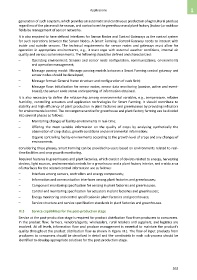Page 573 - 5G Basics - Core Network Aspects
P. 573
Applications 1
generation of such a system, which provides an automatic and continuous production of agricultural produce
regardless of the place and the season, and control over the greenhouse and plant factory (indoor) or outdoor
fields by management of sensor networks.
It is also required to have defined interfaces for Sensor Nodes and Control Gateways as the control system
for such operations between the Sensor Nodes. A Smart Farming. Control Gateway needs to interact with
inside and outside sensors. The technical requirements for sensor nodes and gateways must allow for
operation in appropriate environments, e.g., it must cope with external weather conditions, internal air
quality and various soil environments. The following should be defined and characterized:
– Operating environment: Sensors and sensor node configuration, communications, environments
and operation management;
– Message passing model: Message passing models between a Smart Farming control gateway and
sensor nodes should be developed;
– Message format: General frame structure and configuration of each field;
– Message flow: Initialization for sensor nodes, sensor data monitoring (passive, active and event-
based), the sensor node status and reporting of information obtained.
It is also necessary to define the relationship among environmental variables, e.g., temperature, relative
humidity, controlling actuators and application technologies for Smart Farming. It should contribute to
stability and high efficiency of plant production in plant factories and greenhouses by providing indicators
for environmental control. The convergence service for greenhouse and plant factory farming can be divided
into several phases as follows:
– Monitoring changes of facility environments in real-time;
– Offering the most suitable information on the quality of crops by analysing synthetically the
observation of crop status, growth conditions and environmental information;
– Organic controlling facility environments according to the growth level of crops and any changes of
environments.
Considering these phases, Smart Farming can be provided to users based on environments related to real-
time facilities and crop growth monitoring.
Required features in greenhouses and plant factories, which consist of devices related to energy, harvesting
devices, light sources, environmental controls for a greenhouse and a plant factory interior, and a wide area
of interfaces for the related control information are as follows:
– Interface among sensors, controllers and energy components;
– Information and communication interfaces among plant factories and greenhouses;
– Component monitoring specification for sensing in plant factories and greenhouses;
– Control and monitoring specification for actuators in plant factories and greenhouses;
– Energy monitoring and control specification in plant factories and greenhouses;
– Service structure and service specification standards in plant factories and greenhouses.
III.3 Service capabilities for the post-production stage
Service at the post-production stage is required for product distribution flow from producers to consumers.
In the product flow, farmers, vendors/agents, wholesalers, rural retailers and suppliers, and logistics are
involved. At all levels, information flow and produce management is essential to maintain the product's
quality throughout the product distribution flow as shown in Figure III.1. The flow of input products from
producers to consumers should be described in detail and the constraints in each sub-process should be
identified to develop appropriate solutions for the post-production stage.
563

